Machinability Analysis of Finish-Turning Operations for Ti6Al4V Tubes Fabricated by Selective Laser Melting
Abstract
:1. Introduction
2. Experimental Setup
2.1. Preparation of Workpiece Material
2.2. Turning Experiments
3. Results and Discussion
3.1. Cutting Forces
3.2. Surface Integrity
3.3. Tool Wear
4. Conclusions
- (i)
- The cutting depth is the most influential cutting parameter. Both the main cutting forces (Fc) and radial forces (Fr) when machining SLMed Ti workpieces were lesser (55–70%) than while machining wrought parts at a smaller cutting depth of 0.25 mm. However, an inverse trend was observed at a greater cutting depth of 0.5 mm, where the resultant cutting force when machining the SLMed Ti workpiece was higher by about 10% when machining wrought counterparts.
- (ii)
- The main and radial cutting forces were greater while machining wrought workpieces under all cutting conditions compared to SLMed Ti tubes.
- (iii)
- Vibrational analysis conducted on the cutting forces showed that the main frequency of the main cutting forces was about 1.5 Hz, irrespective of the workpiece condition. However, some high frequency peaks were also found distributed within the range of 200 Hz to 1200 Hz.
- (iv)
- The machined surface roughness of both the wrought and SLMed Ti workpieces were similar, with the roughness below 2 μm, indicating that the roughness in finish machining was not affected by variations in cutting forces and tool wear.
- (v)
- The results obtained from the tool wear analysis shows that there was larger tool–workpiece engagement area on the tools used to machine the wrought parts as compared with that on tools used to machine SLMed parts.
- (vi)
- Both adhesion and attrition wear were found to be the dominant tool wear mechanisms, irrespective of the cutting conditions or the workpiece state.
Author Contributions
Funding
Institutional Review Board Statement
Informed Consent Statement
Data Availability Statement
Acknowledgments
Conflicts of Interest
Nomenclature
| AM | Additive manufacturing |
| PBF | Powder bed fusion |
| EBM | Electron beam melting |
| SLM | Selective laser melting |
| DMLS | Direct metal laser sintering |
| MQL | Minimum quantity lubrication |
| FFT | Fast Fourier Transformation |
| BUE | Build-up edge |
| BUL | Build-up layer |
References
- Li, G.; Chandra, S.; Rashid, R.; Palanisamy, S.; Ding, S. Machinability of additively manufactured titanium alloys: A comprehensive review. J. Manuf. Processes 2022, 75, 72–99. [Google Scholar] [CrossRef]
- Li, G.; Yi, S.; Li, N.; Pan, W.; Wen, C.; Ding, S. Quantitative analysis of cooling and lubricating effects of graphene oxide nanofluids in machining titanium alloy Ti6Al4V. J. Mater. Process. Technol. 2019, 271, 584–598. [Google Scholar] [CrossRef]
- Mower, T.; Long, M. Mechanical behavior of additive manufactured, powder-bed laser-fused materials. Mater. Sci. Eng. A 2016, 651, 198–213. [Google Scholar] [CrossRef]
- Attar, H.; Ehetemam, S.; Kent, D.; Dargusch, M. Recent developments and opportunities in additive manufacturing of titanium-based matrix composites: A review. Int. J. Mach. Tools Manuf. 2018, 133, 85–102. [Google Scholar] [CrossRef]
- Cottam, R.; Palanisamy, S.; Avdeev, M.; Jarvis, T.; Henry, C.; Cuiuri, D.; Balogh, L.; Rashid, R. Diffraction line profile analysis of 3D wedge samples of Ti-6Al-4V fabricated using four different additive manufacturing processes. Metals 2019, 9, 60. [Google Scholar] [CrossRef] [Green Version]
- Ngo, T.D.; Kashani, A.; Imbalzano, G.; Nguyen, K.T.D.; Hui, D. Additive manufacturing (3D printing): A review of materials, methods, applications and challenges. Compos. Part B Eng. 2018, 143, 172–196. [Google Scholar] [CrossRef]
- Hoye, N.; Cuiuri, D.; Rashid, R.; Palanisamy, S. Machining of GTAW additively manufactured Ti-6Al-4V structures. Int. J. Adv. Manuf. Technol. 2018, 99, 313–326. [Google Scholar] [CrossRef]
- Khanna, N.; Zadafiya, K.; Patel, T.; Kaynak, Y.; Rashid, R.; Vafadar, A. Review on machining of additively manufactured nickel and titanium alloys. J. Mater. Res. Technol. 2021, 15, 3192–3221. [Google Scholar] [CrossRef]
- Yan, M.; Yu, P. An Overview of densification, microstructure and mechanical property of additively manufactured Ti-6Al-4V—Comparison among selective laser melting, electron beam melting, laser metal deposition and selective laser sintering, and with conventional powder. Sinter. Tech. Mater. 2015. [Google Scholar] [CrossRef]
- Murr, L.E.; Esquivel, E.V.; Quinones, S.A.; Gaytan, S.M.; Lopez, M.I.; Martinez, E.Y.; Medina, F.; Hernandez, D.H.; Martinez, E.; Martinez, J.L.; et al. Microstructures and mechanical properties of electron beam-rapid manufactured Ti–6Al–4V biomedical prototypes compared to wrought Ti–6Al–4V. Mater. Charact. 2009, 60, 96–105. [Google Scholar] [CrossRef]
- Le Coz, G.; Fischer, M.; Piquard, R.; D’Acunto, A.; Laheurte, P.; Dudzinski, D. Micro cutting of Ti-6Al-4V parts produced by SLM process. Procedia Cirp 2017, 58, 228–232. [Google Scholar] [CrossRef]
- Shunmugavel, M.; Polishetty, A.; Goldberg, M.; Singh, R.; Littlefair, G. A comparative study of mechanical properties and machinability of wrought and additive manufactured (selective laser melting) titanium alloy–Ti-6Al-4V. Rapid Prototyp. J. 2017, 23, 1051–1056. [Google Scholar] [CrossRef]
- Kallel, A.; Duchosal, A.; Altmeyer, G.; Morandeau, A.; Hamdi, H.; Leroy, R.; Méo, S. Finish milling study of Ti-6Al-4V produced by Laser Metal Deposition (LMD). MM Sci. J. 2019, 2019, 3067–3070. [Google Scholar] [CrossRef] [Green Version]
- Hojati, F.; Daneshi, A.; Soltani, B.; Azarhoushang, B.; Biermann, D. Study on machinability of additively manufactured and conventional titanium alloys in micro-milling process. Precis. Eng. 2020, 62, 1–9. [Google Scholar] [CrossRef]
- Bruschi, S.; Bertolini, R.; Bordin, A.; Medea, F.; Ghiotti, A. Influence of the machining parameters and cooling strategies on the wear behavior of wrought and additive manufactured Ti6Al4V for biomedical applications. Tribol. Int. 2016, 102, 133–142. [Google Scholar] [CrossRef]
- Li, G.; Yi, S.; Wen, C.; Ding, S. Wear mechanism and modeling of tribological behavior of polycrystalline diamond tools when cutting Ti6Al4V. J. Manuf. Sci. Eng. 2018, 140, 121011–121026. [Google Scholar] [CrossRef]
- Al-Rubaie, K.S.; Melotti, S.; Rabelo, A.; Paiva, J.M.; Elbestawi, M.A.; Veldhuis, S.C. Machinability of SLM-produced Ti6Al4V titanium alloy parts. J. Manuf. Processes 2020, 57, 768–786. [Google Scholar] [CrossRef]
- Pérez-Ruiz, J.D.; López de Lacalle, L.N.; Urbikain, G.; Pereira, O.; Martínez, S.; Bris, J. On the relationship between cutting forces and anisotropy features in the milling of LPBF Inconel 718 for near net shape parts. Int. J. Mach. Tools Manuf. 2021, 170, 103801. [Google Scholar] [CrossRef]
- Pérez-Ruiz, J.D.; Marin, F.; Martínez, S.; Lamikiz, A.; Urbikain, G.; López de Lacalle, L.N. Stiffening near-net-shape functional parts of Inconel 718 LPBF considering material anisotropy and subsequent machining issues. Mech. Syst. Signal Process. 2022, 168, 108675. [Google Scholar] [CrossRef]
- Lizzul, L.; Sorgato, M.; Bertolini, R.; Ghiotti, A.; Bruschi, S. Influence of additive manufacturing-induced anisotropy on tool wear in end milling of Ti6Al4V. Tribol. Int. 2020, 146, 106200. [Google Scholar] [CrossRef]
- Rodríguez, A.; Calleja, A.; López de Lacalle, L.N.; Pereira, O.; Rubio-Mateos, A.; Rodríguez, G. Drilling of CFRP-Ti6Al4V stacks using CO2-cryogenic cooling. J. Manuf. Processes 2021, 64, 58–66. [Google Scholar] [CrossRef]
- Gonzalez, H.; Pereira, O.; López de Lacalle, L.N.; Calleja, A.; Ayesta, I.; Muñoa, J. Flank-milling of integral blade rotors made in Ti6Al4V using Cryo CO2 and minimum quantity lubrication. J. Manuf. Sci. Eng. 2021, 143, 1–16. [Google Scholar] [CrossRef]
- Amigo, F.J.; Urbikain, G.; Pereira, O.; Fernández-Lucio, P.; Fernández-Valdivielso, A.; López de Lacalle, L.N. Combination of high feed turning with cryogenic cooling on Haynes 263 and Inconel 718 superalloys. J. Manuf. Processes 2020, 58, 208–222. [Google Scholar] [CrossRef]
- Bordin, A.; Imbrogno, S.; Rotella, G.; Bruschi, S.; Ghiotti, A.; Umbrello, D. Finite element simulation of semi-finishing turning of electron beam melted Ti6Al4V under dry and cryogenic cooling. Procedia CIRP 2015, 31, 551–556. [Google Scholar] [CrossRef]
- Sartori, S.; Moro, L.; Ghiotti, A.; Bruschi, S. On the tool wear mechanisms in dry and cryogenic turning Additive Manufactured titanium alloys. Tribol. Int. 2017, 105, 264–273. [Google Scholar] [CrossRef]
- Pimenov, D.Y.; Mia, M.; Gupta, M.K.; Machado, A.R.; Tomaz, Í.V.; Sarikaya, M.; Wojciechowski, S.; Mikolajczyk, T.; Kapłonek, W. Improvement of machinability of Ti and its alloys using cooling-lubrication techniques: A review and future prospect. J. Mater. Res. Technol. 2021, 11, 719–753. [Google Scholar] [CrossRef]
- Khaliq, W.; Zhang, C.; Jamil, M.; Khan, A.M. Tool wear, surface quality, and residual stresses analysis of micro-machined additive manufactured Ti–6Al–4V under dry and MQL conditions. Tribol. Int. 2020, 151, 106408. [Google Scholar] [CrossRef]
- Cao, H.; Zhou, K.; Chen, X. Stability-based selection of cutting parameters to increase material removal rate in high-speed machining process. Proc. Inst. Mech. Eng. Part B J. Eng. Manuf. 2016, 230, 227–240. [Google Scholar] [CrossRef]
- Kallel, A.; Duchosal, A.; Hamdi, H.; Altmeyer, G.; Morandeau, A.; Méo, S. Analysis of the surface integrity induced by face milling of Laser Metal Deposited Ti-6Al-4V. Procedia CIRP 2020, 87, 345–350. [Google Scholar] [CrossRef]
- Rotella, G.; Imbrogno, S.; Candamano, S.; Umbrello, D. Surface integrity of machined additively manufactured Ti alloys. J. Mater. Process. Technol. 2018, 259, 180–185. [Google Scholar] [CrossRef]
- Bahi, S.; Nouari, M.; Moufki, A.; EI Mansori, M.; Molinari, A. Hybrid modelling of sliding–sticking zones at the tool–chip interface under dry machining and tool wear analysis. Wear 2012, 286–287, 45–54. [Google Scholar] [CrossRef]
- Rashid, R.; Palanisamy, S.; Sun, S.; Dargusch, M. Tool wear mechanisms involved in crater formation on uncoated carbide tool when machining Ti6Al4V alloy. Int. J. Adv. Manuf. Technol. 2016, 83, 1457–1465. [Google Scholar] [CrossRef]
- Dargusch, M.; Sivarupan, T.; Bermingham, M.; Rashid, R.; Palanisamy, S.; Sun, S. Challenges in laser-assisted milling of titanium alloys. Int. J. Extrem. Manuf. 2021, 3, 015001. [Google Scholar] [CrossRef]

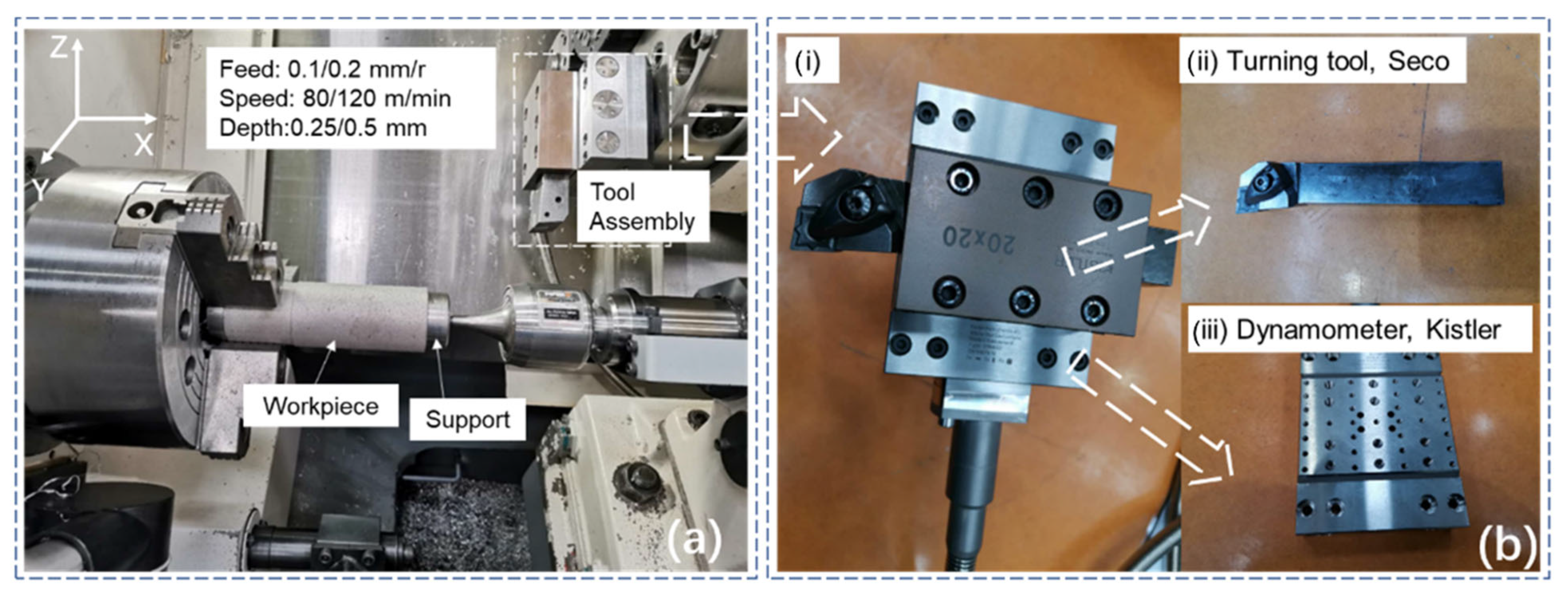


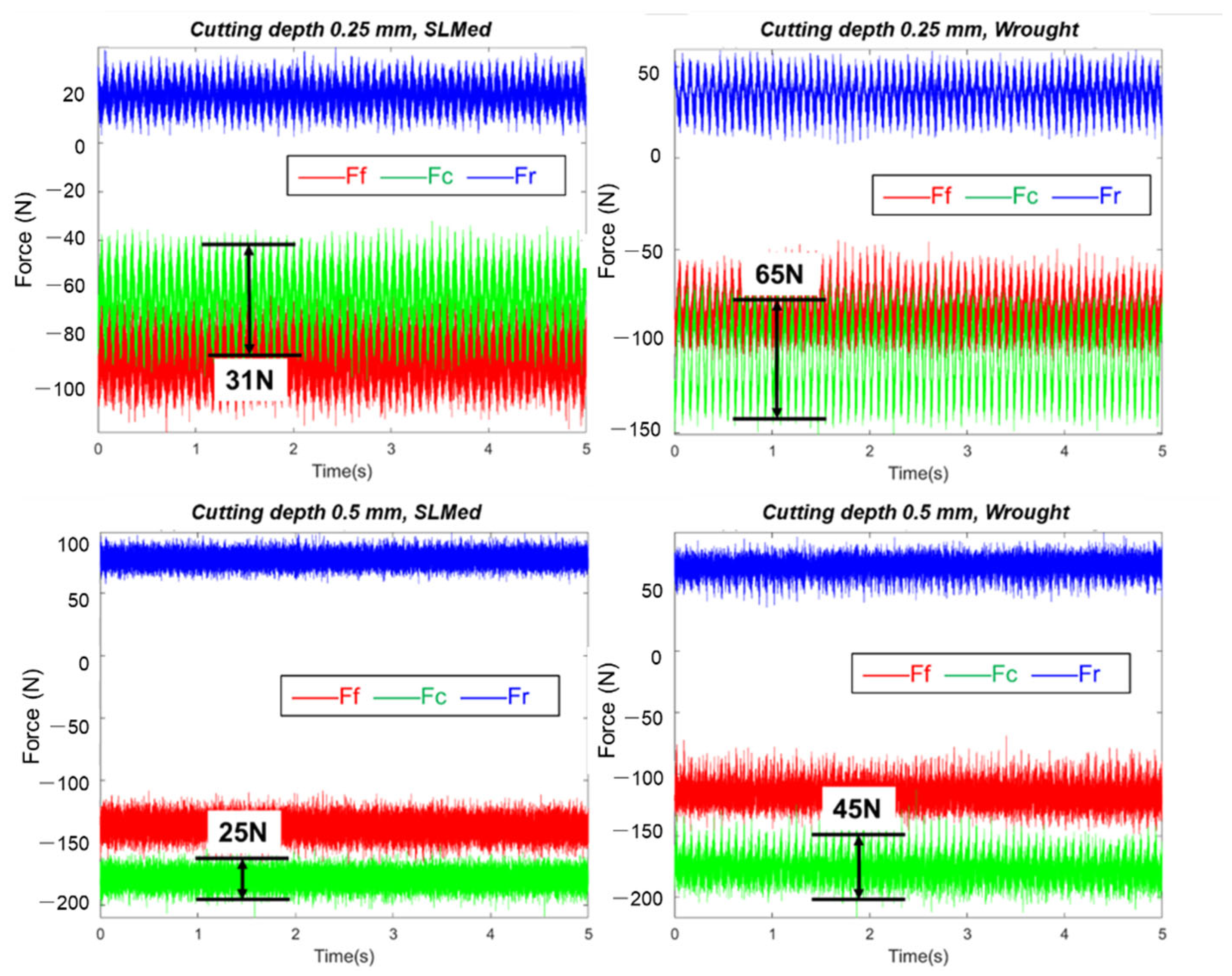
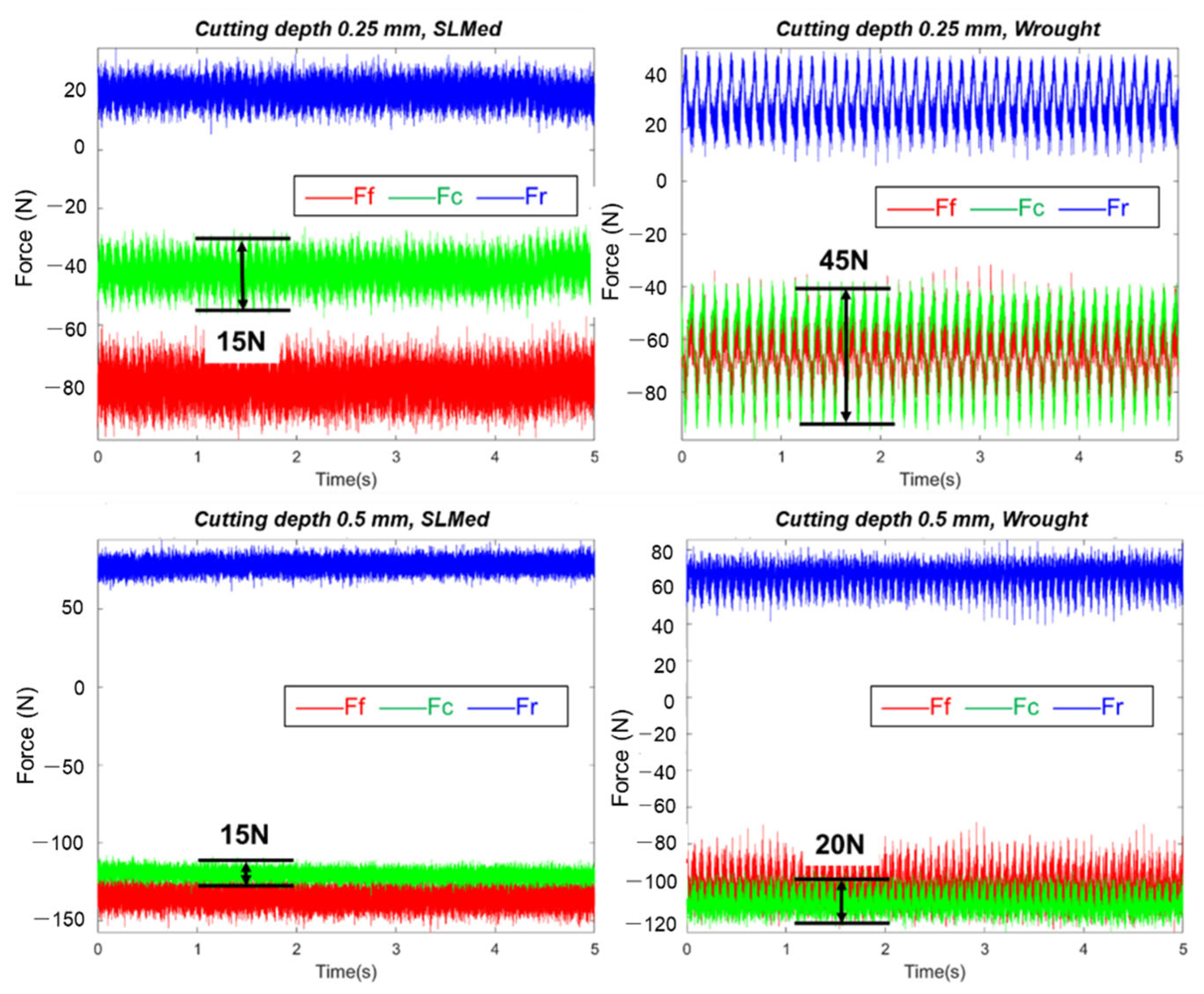
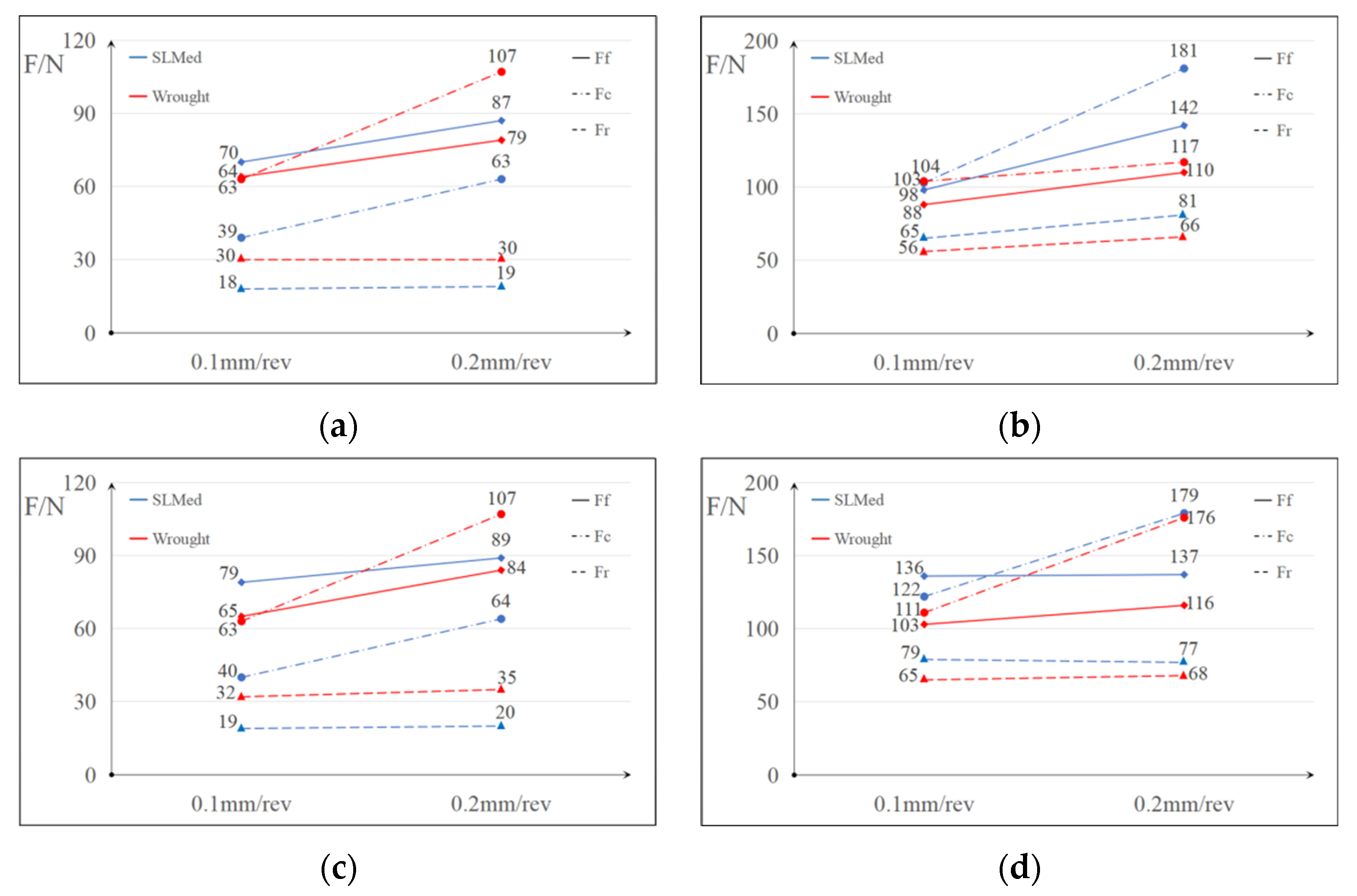


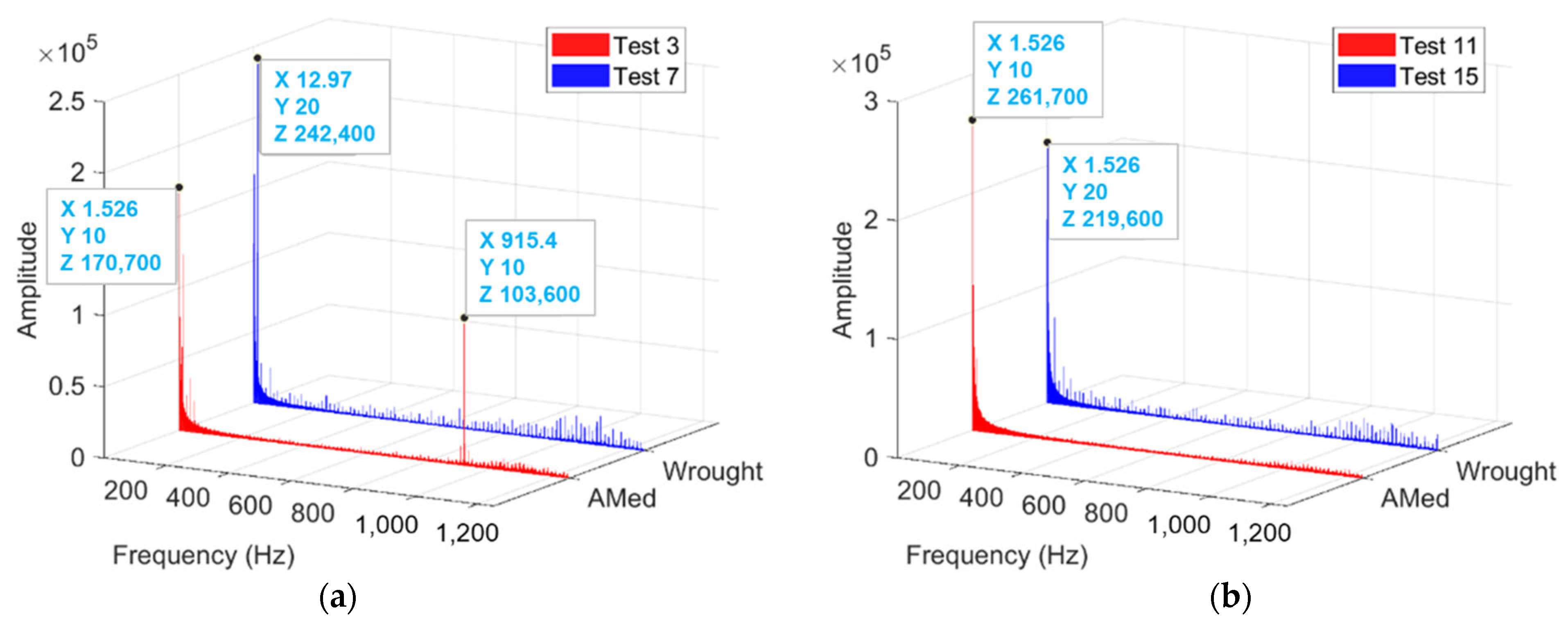
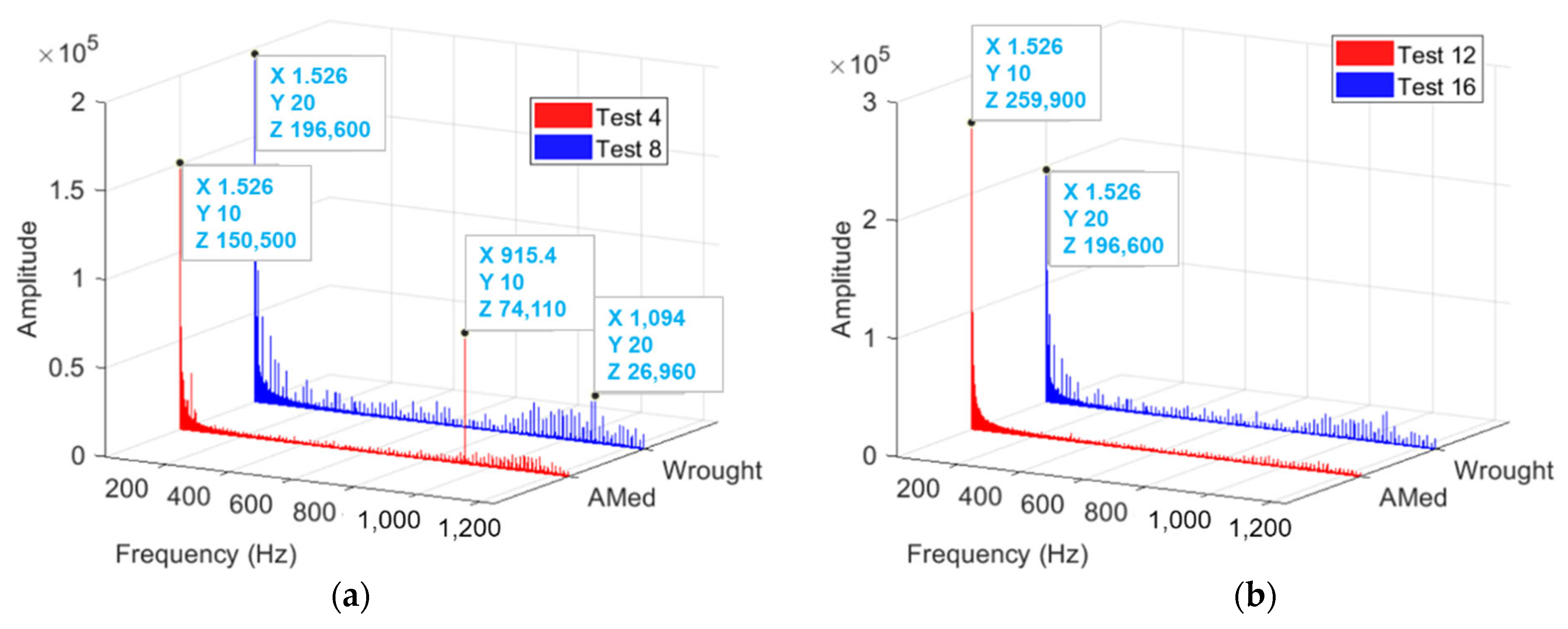

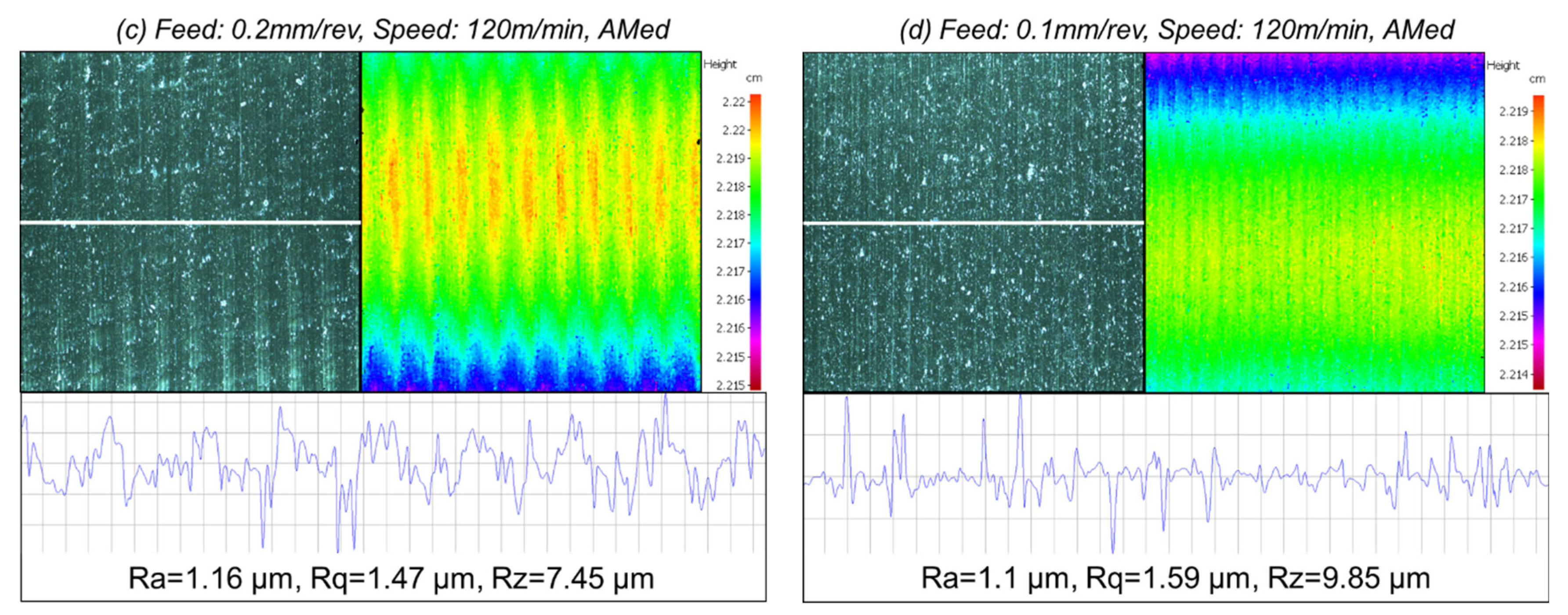
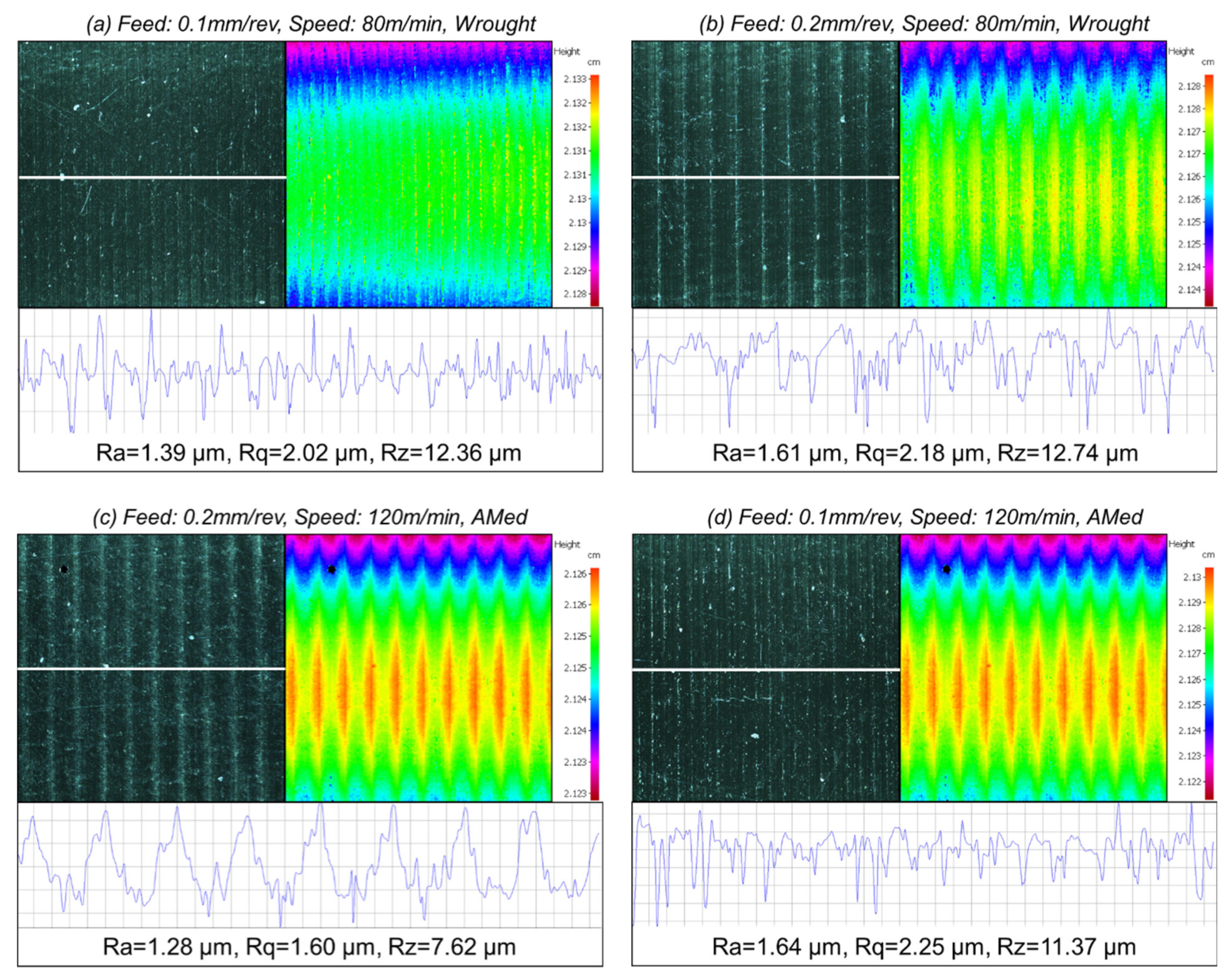
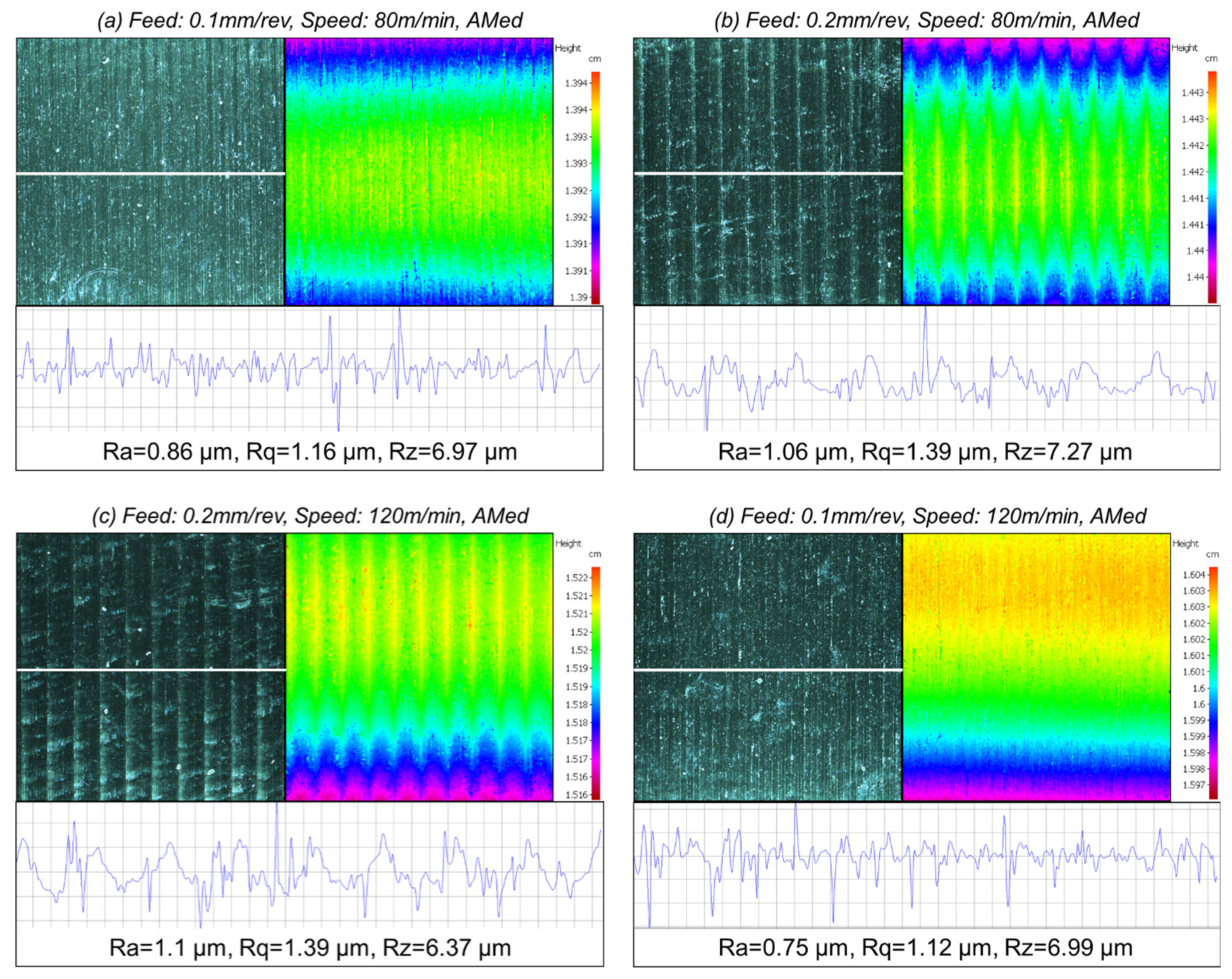
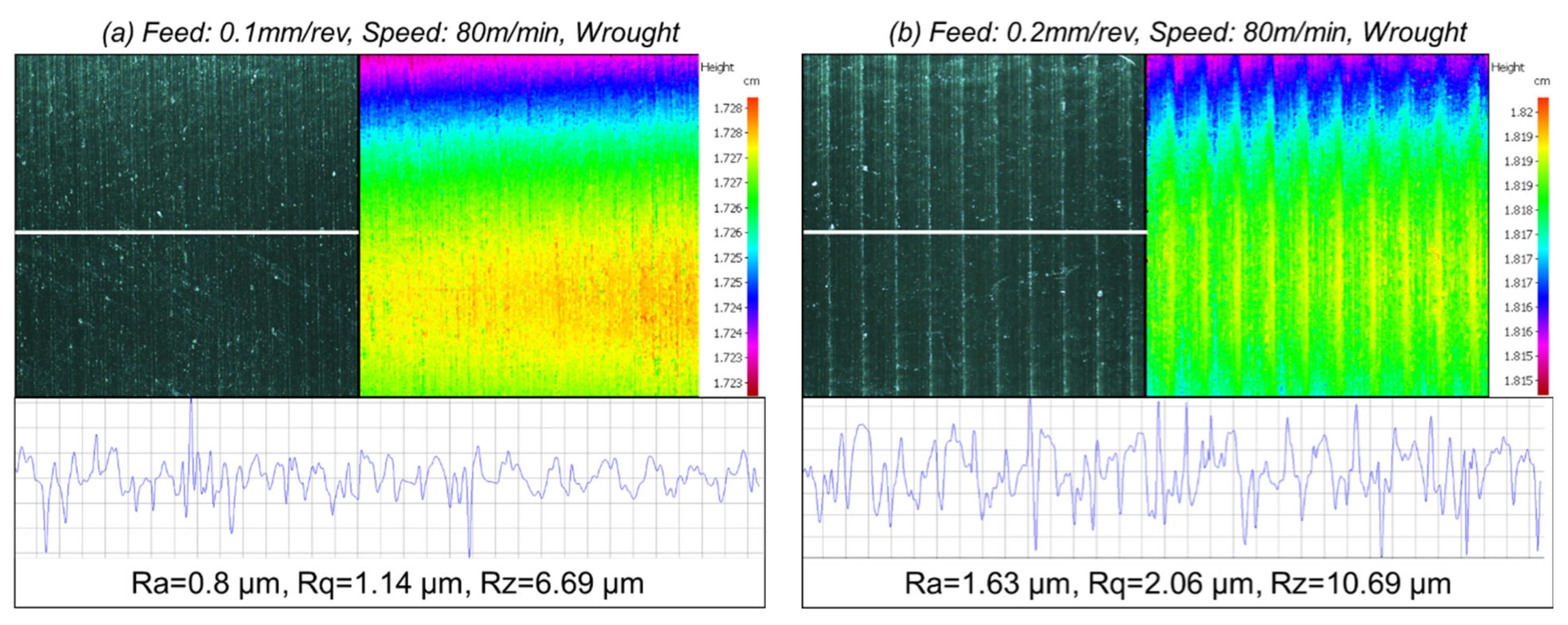

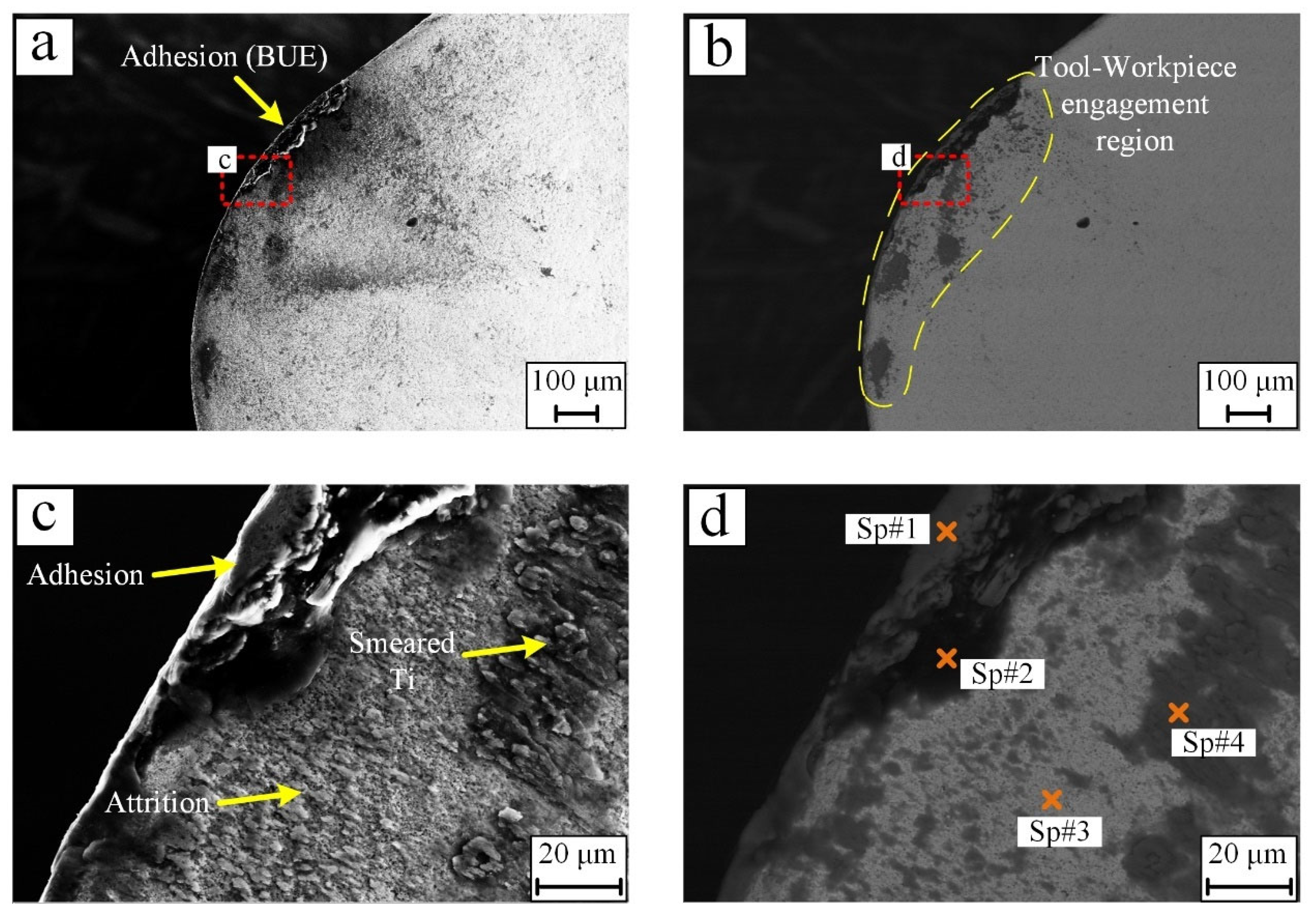
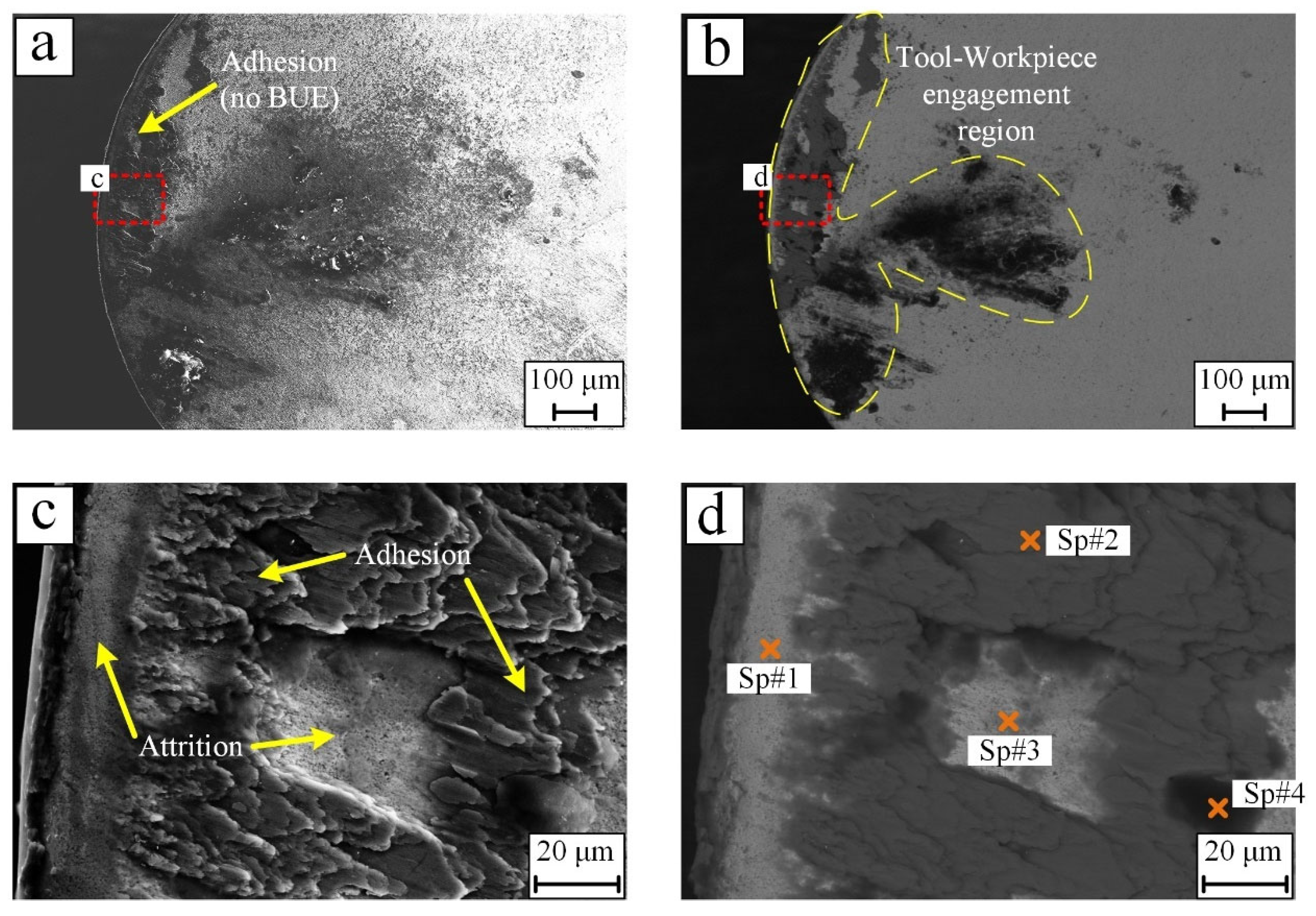

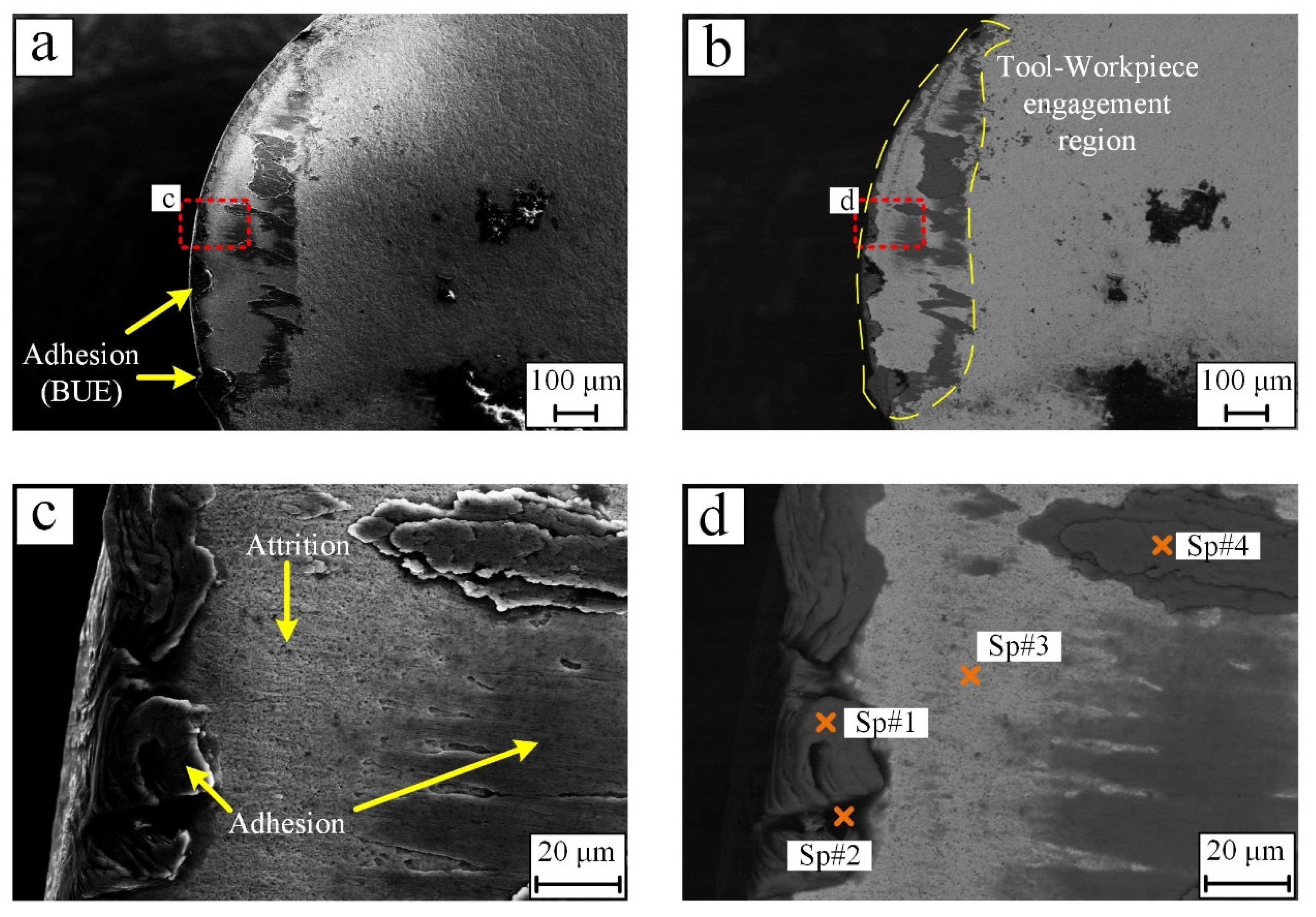
| Fabrication Method | Hardness (HRC) | Yield Strength (MPa) | Tensile Strength (MPa) | Elastic Modulus (GPa) |
|---|---|---|---|---|
| Wrought | 31 | 790 | 872 | 118 |
| EBM | 35 | 830 | 914 | 114 |
| SLM | 41 | 1125 | 1250 | 94 |
| DMLS | 44 | 990 | 1095 | 110 |
| Insert View | Clearance Angle | Included Angle | Cutting Edge Length | Corner Radius |
|---|---|---|---|---|
 | 0° | 80° | 12.9 mm | 0.8 mm |
| Test No. | Feed Rate (mm/rev) | Cutting Speed (m/min) | Cutting Depth (mm) | Workpiece |
|---|---|---|---|---|
| 1 | 0.1 | 80 | 0.25 | SLMed |
| 2 | 0.2 | |||
| 3 | 120 | |||
| 4 | 0.1 | |||
| 5 | 80 | Wrought | ||
| 6 | 0.2 | |||
| 7 | 120 | |||
| 8 | 0.1 | |||
| 9 | 80 | 0.5 | SLMed | |
| 10 | 0.2 | |||
| 11 | 120 | |||
| 12 | 0.1 | |||
| 13 | 80 | Wrought | ||
| 14 | 0.2 | |||
| 15 | 120 | |||
| 16 | 0.1 |
| Cutting Depth | Workpiece | Cutting Forces | 80 m/min 0.1 mm/rev | 80 m/min 0.2 mm/rev | 120 m/min 0.1 mm/rev | 120 m/min 0.2 mm/rev |
|---|---|---|---|---|---|---|
| 0.25 mm | SLMed | Fres | 82 N | 82 N | 90 N | 111 N |
| Wrought | Fres | 95 N | 135 N | 96 N | 140 N | |
| 0.5 mm | SLMed | Fres | 156 N | 244 N | 199 N | 238 N |
| Wrought | Fres | 147 N | 219 N | 165 N | 222 N |
| Tool Elements | Workpiece Elements | Other | |||||
|---|---|---|---|---|---|---|---|
| W | C | Co | Ti | Al | V | O | |
| Sp#1 | 0.45 | 23.62 | 0.13 | 61.22 | 3.80 | 1.69 | 8.81 |
| Sp#2 | 3.35 | 73.47 | 0.38 | 12.17 | 1.03 | 0.88 | 8.09 |
| Sp#3 | 58.77 | 28.50 | 2.23 | 6.09 | 0.44 | 0.21 | 2.67 |
| Sp#4 | 12.94 | 22.88 | 0.29 | 54.78 | 2.95 | 1.76 | 4.27 |
| Tool Elements | Workpiece Elements | Other | |||||
|---|---|---|---|---|---|---|---|
| W | C | Co | Ti | Al | V | O | |
| Sp#1 | 78.51 | 13.04 | 2.24 | 2.36 | 0.39 | 0.10 | 3.32 |
| Sp#2 | 0.92 | 13.46 | 0.02 | 76.91 | 4.35 | 2.15 | 2.19 |
| Sp#3 | 39.48 | 27.82 | 2.14 | 17.63 | 1.63 | 0.67 | 10.47 |
| Sp#4 | 3.07 | 49.08 | 0.40 | 20.11 | 0.96 | 0.67 | 22.09 |
| Tool Elements | Workpiece Elements | Other | |||||
|---|---|---|---|---|---|---|---|
| W | C | Co | Ti | Al | V | O | |
| Sp#1 | 0.57 | 19.59 | 0.07 | 73.13 | 3.34 | 1.95 | 1.23 |
| Sp#2 | 62.79 | 11.72 | 9.04 | 12.78 | 1.39 | 0.39 | 2.14 |
| Sp#3 | 1.51 | 14.47 | 0.07 | 76.80 | 4.55 | 2.23 | 0.17 |
| Sp#4 | 6.78 | 46.78 | 0.29 | 19.88 | 1.84 | 0.53 | 21.86 |
| Tool Elements | Workpiece Elements | Other | |||||
|---|---|---|---|---|---|---|---|
| W | C | Co | Ti | Al | V | O | |
| Sp#1 | 0.78 | 3.70 | 0.08 | 76.41 | 7.08 | 3.38 | 8.10 |
| Sp#2 | 40.31 | 26.81 | 2.16 | 23.69 | 0.59 | 1.27 | 5.17 |
| Sp#3 | 88.4 | 2.97 | 1.65 | 4.81 | 0.69 | 0.31 | 1.17 |
| Sp#4 | 1.37 | 2.21 | 0.08 | 88.16 | 4.72 | 3.25 | 0.21 |
Publisher’s Note: MDPI stays neutral with regard to jurisdictional claims in published maps and institutional affiliations. |
© 2022 by the authors. Licensee MDPI, Basel, Switzerland. This article is an open access article distributed under the terms and conditions of the Creative Commons Attribution (CC BY) license (https://creativecommons.org/licenses/by/4.0/).
Share and Cite
Li, G.; Rahman Rashid, R.A.; Ding, S.; Sun, S.; Palanisamy, S. Machinability Analysis of Finish-Turning Operations for Ti6Al4V Tubes Fabricated by Selective Laser Melting. Metals 2022, 12, 806. https://doi.org/10.3390/met12050806
Li G, Rahman Rashid RA, Ding S, Sun S, Palanisamy S. Machinability Analysis of Finish-Turning Operations for Ti6Al4V Tubes Fabricated by Selective Laser Melting. Metals. 2022; 12(5):806. https://doi.org/10.3390/met12050806
Chicago/Turabian StyleLi, Guangxian, Rizwan Abdul Rahman Rashid, Songlin Ding, Shoujin Sun, and Suresh Palanisamy. 2022. "Machinability Analysis of Finish-Turning Operations for Ti6Al4V Tubes Fabricated by Selective Laser Melting" Metals 12, no. 5: 806. https://doi.org/10.3390/met12050806






